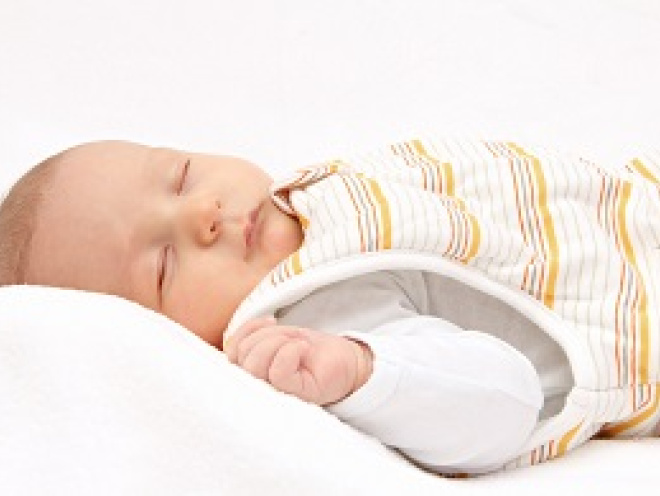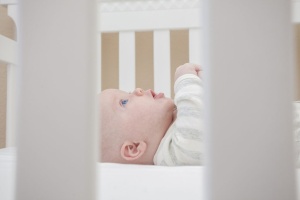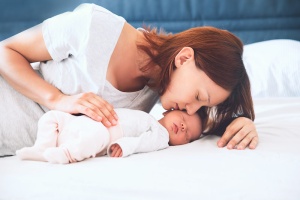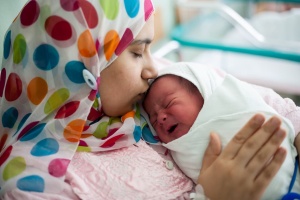It’s one of the most important things to get right with a newborn. Here are your burning questions on your baby’s sleep positions answered.
What is the best sleeping position for my baby?
It’s important that you put your baby to sleep on their back, unless your doctor has said otherwise based on medical reasons. Lying your baby down in that position is one of the best ways of making sure they drift off as safely as possible.
Ok, but why is it important to put my baby to sleep on their back?
A lot of evidence shows that lying your baby on their back to sleep significantly reduces their risk of sudden infant death syndrome (SIDS) (Engelberts and de Jonge, 1990; Engelberts et al, 1991; Wigfield et al, 1992; Dwyer and Ponsonby, 1996; Office for National Statistics, 2000; Alm et al, 2001; General Register Office for Scotland, 2001; Northern Ireland Statistics and Research Agency, 2001; Office for National Statistics, 2001).
"You should put them in this position for every single sleep or nap."
This is because the chance of SIDS is particularly high in babies who are only sometimes placed on their front or side (L’Hoir et al, 1998; Mitchell et al, 1999; Li et al, 2003).
What if my baby rolls on to their front?
If you notice that your newborn baby has rolled on to their tummy, gently turn them back. Soon enough your baby will roll from back to front and back again on their own – usually a milestone they hit from around five months old (WHO Multicentre Growth Reference Study Group, 2006; NHS Choices, 2011). When that happens, you can leave them to find their own position.
My mum tells me that babies used to sleep on their front – why has the advice changed?
Ah, the grandparent wisdom… Well, it’s true that up until 1991, the recommendation given to parents was to put babies on their tummies. Newer research shows that the chance of SIDS is much higher when a baby is placed on their front to sleep (L’Hoir et al, 1998; Mitchell et al, 1999; Li et al, 2003).
Just make sure your baby has plenty of tummy time during the day when you can supervise. This reduces their risk of flat head syndrome (plagiocephaly or brachycephaly) (Pin et al, 2007; NHS Choices, 2016).
How can I encourage my baby to sleep on their back?
The best way to make sure your baby sleeps on their back is to put them in that position straight away. Keep it up with every sleep, at night and for naps (Blair et al, 2006a).
Don’t use any type of equipment or rolled up blankets to wedge your baby in one position (FDA, 2017; Lullaby Trust, 2018). That is, unless a health professional has advised you to do so. For more information, see our page on cot safety.
If my baby has reflux, is sleeping on their front advised?
All babies – including those with reflux – should sleep on their back as it’s the safest position (Oyen et al, 1997; Blair et al, 2006b). The only exception is if a medical professional has given you different advice. Do speak to your GP or midwife if you’re worried about reflux too.
My baby was premature and slept on their front in hospital – surely I should carry that on at home?
Almost definitely not. Your baby might have been placed on their front in the neonatal unit for medical reasons. But remember, they were under constant supervision there.
Once you and your baby are back at home, the safest position for them is on their back. Unless the paediatricians who were looking after them have told you differently, your baby should be on their back (Oyen et al, 1997; Blair et al, 2006).
This page was last reviewed in February 2018.
Further information
Our support line offers practical and emotional support with feeding your baby and general enquiries for parents, members and volunteers: 0300 330 0700.
The Lullaby Trust has lots of useful information and support for parents about safe sleep.
Unicef’s Baby Friendly Resources has a comprehensive guide on Caring For Your Baby At Night
You might find attending one of our NCT New Baby groups helpful as they give you the opportunity to explore different approaches to important parenting issues with a qualified group leader and other new parents in your area.
Make friends with other parents-to-be and new parents in your local area for support and friendship by seeing what NCT activities.
Alm B, Norvenius SG, Wennergren G, Skjaerven R, Øyen N, Milerad J, et al. (2001) Changes in the epidemiology of sudden infant death syndrome in Sweden 1973-1996. Arch Dis Child. 84(1):24-30. Available from: https://www.ncbi.nlm.nih.gov/pubmed/11124779 [Accessed 1st February 2018]
Ball H, Blair P. (2017) Health professionals’ guide to caring for your baby at night. Unicef Baby Friendly UK. Available from: https://www.unicef.org.uk/babyfriendly/wp-content/uploads/sites/2/2011/11/Caring-for-your-Baby-at-Night-A-Health-Professionals-Guide.pdf [Accessed 1st February 2018]
Blair PS, Platt MW, Smith IJ, Fleming PJ. (2006a) Sudden infant death syndrome and the time of death: factors associated with night-time and day-time deaths. Int J Epidemiol. 35(6):1563-1569. Available from: https://www.ncbi.nlm.nih.gov/pubmed/17148463 [Accessed 1st February 2018]
Blair PS, Platt MW, Smith IJ, Fleming PJ. (2006b) Sudden infant death syndrome and sleeping position in pre-term and low birth weight infants: an opportunity for targeted intervention. Arch Dis Child. 91(2):101-106. Available from: https://www.ncbi.nlm.nih.gov/pubmed/15914498 [Accessed 1st February 2018]
Dwyer T, Ponsonby AL. (1996) The decline of SIDS: a success story for epidemiology. Epidemiology. 7(3):323-325. Available from: https://www.ncbi.nlm.nih.gov/pubmed/8728452 [Accessed 1st February 2018]
Engelberts AC, de Jonge GA. (1990) Choice of sleeping position for infants: possible association with cot death. Arch Dis Child. 65(4):462-467. Available from: https://www.ncbi.nlm.nih.gov/pubmed/2189370 [Accessed 1st February 2018]
Engelberts AC, de Jonge GA, Kostense PJ. (1991) An analysis of trends in the incidence of sudden infant death in The Netherlands 1969-89. J Paediatr Child Health. 27(6):329-333. Available from: https://www.ncbi.nlm.nih.gov/pubmed/1756073 [Accessed 1st February 2018]
FDA. (2017) Do not use infant sleep positioners due to the risk of suffocation. Available from: https://www.fda.gov/ForConsumers/ConsumerUpdates/ucm227575.htm [Accessed 1st February 2018]
Fleming PJ, Bacon C, Blair PS, Berry PJ. (2000) Sudden unexpected deaths in infancy. The CESDI SUDI studies 1993-1996. The Stationery Office, London.
L'Hoir MP, Engelberts AC, van Well GT, McClelland S, Westers P, Dandachli T, et al. (1998) Risk and preventive factors for cot death in The Netherlands, a low-incidence country. Eur J Pediatr. 157(8): 681-688. Available from: https://www.ncbi.nlm.nih.gov/pubmed/9727856 [Accessed 1st February 2018]
Li DK, Petitti DB, Willinger M, McMahon R, Odouli R, Vu H, et al. (2003) Infant sleeping position and the risk of sudden infant death syndrome in California, 1997-2000. Am J Epidemiol. 157:446-455. Available from: https://www.ncbi.nlm.nih.gov/pubmed/12615609 [Accessed 1st February 2018]
Lullaby Trust. (2016) Evidence Base. Available from: https://www.lullabytrust.org.uk/research/evidence-base [Accessed 1st February 2018]
Lullaby Trust. (2017) Are sleep positioners safe for babies? Available from: https://www.lullabytrust.org.uk/are-sleep-positioners-safe-for-babies [Accessed 1st February 2018]
Mitchell EA, Thach BT, Thompson JM, Williams S. (1999) Changing infants' sleep position increases risk of sudden infant death syndrome. New Zealand Cot Death Study. Arch Pediatr Adolesc Med. 153(11):1136-1141. Available from: https://www.ncbi.nlm.nih.gov/pubmed/10555714 [Accessed 1st February 2018]
NHS Choices. (2016) Plagiocephaly and brachycephaly (flat head syndrome). Available from: https://www.nhs.uk/conditions/plagiocephaly-brachycephaly/ [Accessed 1st February 2018]
Oyen N, Markestad T, Skaerven R, Irgens LM, Helweg-Larsen K, Alm B, et al. (1997) Combined effects of sleeping position and prenatal risk factors in sudden infant death syndrome: the Nordic Epidemiological SIDS Study. Pediatrics. 100(4):613-21. Available from: https://www.ncbi.nlm.nih.gov/pubmed/9310514 [Accessed 1st February 2018]
Pin T, Eldridge B and Galea MP. (2007) A review of the effects of sleep position, play position and equipment use on motor development of infants. Development Medicine and Child Neurology. 49:858-867 Available from: https://www.ncbi.nlm.nih.gov/pubmed/17979866 [Accessed 1st February 2018]
Wigfield RE, Fleming PJ, Berry PJ, Rudd PT, Golding J. (1992) Can the fall in Avon's sudden infant death rate be explained by changes in sleeping position? BMJ. 304(6822):282-3. Available from: https://www.ncbi.nlm.nih.gov/pubmed/1739827 [Accessed 1st February 2018]







